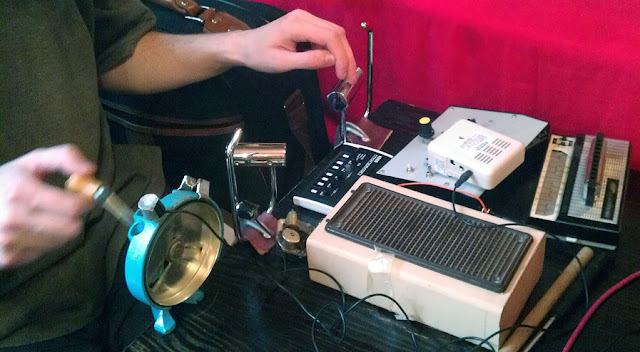 |
| Tapedropping: For Thee... |
It is frustrating to find that audio cassettes are now obsolete. I say this not out of nostalgia, but because cassettes were the ideal medium for mediadropping (that is, anonymously leaving homemade music in random places). Indeed, prior to the manifest decline of the cassette in around 2004, I referred to mediadropping as
tapedropping. The neologism mediadropping came later.
Available
here is a paper entitled
Mediadropping Musings detailing the practice and philosophy of mediadropping / tapedropping. The essay formed part of a larger collection which were often dropped likewise in acts of pamphlet-dropping. This particular text is reproduced here with all its original faults, but remains a useful document for any effusionist.
The majority of people no longer own equipment to play cassettes. This practice of mediadropping is now almost completely thwarted by lack of suitable media. CD-dropping was experimented with, but CDs can also carry data. I have conducted wide-ranging dropping experiments using both CDs and tapes bearing email addresses in order to harvest responses. CD-droppings have low response rates. There is perhaps a sense that CDs can carry computer viruses or even just potentially
*too graphic* multimedia experiences. This makes people loath to pick up a rogue CD-R, even if enticing cover art is provided. Cassettes, in contrast, are obviously meant for audio - tapes are mysterious Pandora's boxes which rouse curiosity concerning their content.
 |
| Tapedropping: Bad Trad |
In recent years, tapes have become 'cool' again for their retro appeal in niche circles. These people who maintain the tape mantle are, however, too knowing to be targeted as tapedropping recipients. The ideal audience for tapedroppings are just
ever-so-slightly leftfield of the middle-of-the-road, but generally uncaring shits - the very people who have now migrated from tape to the latest invisible mp3 zapping technology. It is a shame.
My own early tapedroppings were anything but 'cool'. They were rabid affairs characterised by an element of 'trolling' (before the word came to represent foul cyber-desecrations of basic human decency). Early tapedroppings were directed at aggressors, muse-stiflers, intimidatingly dull bastards, etc. Often, the tapes smacked of puritanical fanaticism and stoic exhortation against the utterly arrogant sexual mores of tacky, brutish schoolboys.
Tapedropping 'music' is rather like a personal individualistic manifestation of what used to be called "
rough music" (see E. P. Thompson's chapter in
Customs in Common for an excellent overview). 'Rough music' involved a "rude cacophony" produced by sections of the community to mock or wind up certain persons who had transgressed community norms. Tapedropping is rather rough music's reversal, in that it is generally directed back at the community norms.
 |
| Rough Music in Warwickshire, 1909 |
During schooldays I was keen on the concept of thought-vengeance. A perceived injustice should always be repaid by an anonymously deposited cassette containing specially tailored semi-musical, sonically-distorted composition-rants, all creatively fuelled by the bitterly energising gall-whisk of futility. Often, these 'injustices' didn't even involve me - for instance, when a quiet boy was kicked downstairs by fourth-formers known to me, I would enact a tapedropping vengeance on the victim's behalf. An agitating listening experience would be dispensed, timed in such a manner that it wouldn’t be attributed to myself.

Regrettably, many of the early cassettes were unique - no other copies existed other than the master copies deposited for their intended recipients. I recall most of the audio-pieces were noisy affairs (turning the air many shades of blue - on tape) intended not only for bully-types, but also those unwittingly cruel ‘casual-bullies’ whose demotivating throwaway remarks were more potent than sustained targeting due to their ‘coolness’. Cassettes were left in their desk drawers, lockers and in their shoes during gym lessons, among other places. To effectively irk the deserving targets, it was necessary to give the impression that the cassette originated from somebody much older. An intricately constructed soundscape was also needed to give the impression that considerable effort had been expended on the article. Overt obnoxiousness was withheld, pitches were lowered and efforts were made at robust articulation. Even more effective was the inclusion of the target’s own voice (distorted and made ridiculous through processing) which I might surreptitiously capture on a portable dictaphone during breaktimes and lessons. On one occasion I gained access to the French teacher’s cupboard where she stored tape recordings of every pupil’s spoken assignments - all the pupils’ names alphabetically arranged. This was fantastic sonic material. Later, I would obtain information to weave into lyrical matter by creepily browsing records in the school office (obtaining information such as home addresses and parents’ professions) and phoning the parents from phone-boxes to extract information or to record their voices for later processing.
Special instruments were built from soft drink cans, bits of wheelbarrow and the cord found in the waistbands of elasticated trousers. The more confusing sounds produced, the better.
I noticed that these tapedroppings could bring about changes of behaviour in their targets. Beholders of rogue cassettes loudly voiced their concerns over the following days, playing detective to fathom the origins and purpose of the strange anti-gift. Answers were never forthcoming, but gossip and false information were: “Mr. Foulsham made that cassette because he hates your mum”, etc. Generally, a few weeks after receiving the cassette, the recipient became softer and less liable to abuse quieter people - a good thing. The effects weren’t so lasting on dyed-in-the-wool bullies, but certainly the ‘casual-bullies’ became more pleasant.
Countless tapes were deployed, but I tried to avoid targeting the same person twice or thrice. My philosophy was that you only get one chance at this kind of operation, so it had better be a good one! If a recipient were to receive a second tape, he would be more mentally prepared and its potency would be lost.
At some stage it became apparent that certain combinations of sounds, voice information, treatments and ‘instrumentation’ were more effective at affecting a target than others. Catchiness of chant or melody was certainly potent. Without referring back to a master tape, it was impossible to judge what compositions were the most successful. Until this point, I had been recording directly to cassette using my parents’ hi-fi and dubbing extra tracks by using the second tape deck. At a car boot sale around 1998, I obtained a four-track, so I began constructing ‘stock’ backing tracks, leaving space for different voice dubbings each time to be tailored for the specific target. The four-track machine enabled the re-use of certain flights of sound combinations and the retaining of copies.

With age comes maturity, and with maturity comes the unlikelihood of honest puerility. This makes these targeted ‘mediadroppings’ even more discordant, thus memorable, for the recipient. Aged eighteen, whilst most of my fellows were desperately trying to cultivate some kind of misguided competitive strut, I thought it to be the perfect time to puncture their fledgling pseudo-poise with tapes of ever-sophisticating dispensation. Tissue-box zithers were strung with extra strings. There were persons whom I had not yet repaid for past aggressions upon me, some stretching back years. At this time, CD-Rs were becoming popular, so the sonics took on a digital slant. With CD-Rs there is the aforementioned problem that the media itself can be mistaken for computer data, thus requiring a printed sleeve to indicate that it is indeed a ‘harmless’ audio CD. Some printed sleeves featured voyeuristic grainy digital photographs I had taken of the targets from some distance. These personalised sleeves created such a furore (with incredible near-tearfulness) throughout the sixth form common room that I desisted from this particular graphic quirk, as it seemed to detract from the audio content which should be the focus.

At college, a more altruistic route was taken with the tapedroppings. I reverted back to cassette and randomly made tapedroppings on a near-industrial scale all around public places. I mainly strove to create an interesting listening experience for random people who happened to stumble across the tapes. Encouragement was also given in the supplementary sleeves for the random recipient to create his/her own sonic deployments. I wanted to hear what other people were sonically capable of when all obligations to follow musical trends were discarded. Crucially, an email address was provided on the tapes. Email allowed for recipient feedback, and many responses were harvested this way. With catalogue numbers on each cassette, the recipient could be asked to cite the number, and thus the actual material would be identified and subsequently honed further and further toward the most reaction-eliciting sonics.
The document
Mediadropping Musings highlights the various shades of severity in tapedropping sentiment. I have divided these into three categories:
Subdued,
Burlesque and
Wayward. The dangers of 'wayward' mediadroppings are also detailed therein. Without the surreal, artistic, fantastical, incoherent and abstract elements, mediadropping can be hijacked by the aforementioned "dull bastards" who may use anonymity to extend their bullydom and make comically sick provocations to strangers. This is what we see happening online with the 'unacceptable' face of 'trolling'. It is vital, therefore, that the mechanics of mediadropping are understood in order to "troll the troll" in attempts to restore equilibrium where possible. In the digital age, it is, sadly, difficult to coerce people to play unsolicited audio from an unknown web source. Here's hoping a new physical audio format suited to mediadropping may emerge in the future!

 One may well wonder about the origins of post-electronic music. I had often wondered if an 'acoustic equivalent' of a synthesiser was theorised during the electronic music heyday of the 1970s, or even earlier. It seems that this was indeed almost touched upon by Terence Dwyer in his 1975 school course Making Electronic Music (Book 2 - Advanced). The work of Terence Dwyer (now in his 90s) has received fresh attention recently thanks to Ian Helliwell's captivating article in last month's The Wire (#343).
One may well wonder about the origins of post-electronic music. I had often wondered if an 'acoustic equivalent' of a synthesiser was theorised during the electronic music heyday of the 1970s, or even earlier. It seems that this was indeed almost touched upon by Terence Dwyer in his 1975 school course Making Electronic Music (Book 2 - Advanced). The work of Terence Dwyer (now in his 90s) has received fresh attention recently thanks to Ian Helliwell's captivating article in last month's The Wire (#343).

























